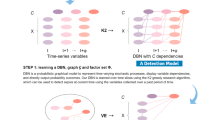Abstract
Sepsis is a life-threatening condition caused by an inappropriate immune response to infection, and is a leading cause of elderly death globally. Early recognition of patients and timely antibiotic therapy based on guidelines improve survival rate. Unfortunately, for those patients, it is often detected late because it is too expensive and impractical to perform frequent monitoring for all the elderly. In this paper, we present a risk driven sepsis screening and monitoring framework to shorten the time of onset detection without frequent monitoring of all the elderly. Within this framework, the sepsis ultimate risk of onset probability and mortality is calculated based on a novel temporal probabilistic model named Auto-BN, which consists of time dependent state, state dependent property, and state dependent inference structures. Then, different stages of a patient are encoded into different states, monitoring frequency is encoded into the state dependent property, and screening content is encoded into different state dependent inference structures. In this way, the screening and monitoring frequency and content can be automatically adjusted when encoding the sepsis ultimate risk into the guard of state transition. This allows for flexible manipulation of the tradeoff between screening accuracy and frequency. We evaluate its effectiveness through empirical study, and incorporate it into existing medical guidance system to improve medical healthcare.








Similar content being viewed by others
Notes
1 Noting that SIRS condition can also be triggered by an infection, but it can also arise from noninfectious sources such as trauma, hemorrhage, burns, surgery, adrenal insufficiency, pulmonary embolism, or drug overdose etc.
2 We only consider vital signs in this example, and the history diseases should also be considered in real applications.
References
Alberti, C., Brun-Buisson, C., Burchardi, H., Martin, C., Goodman, S., Artigas, A., Sicignano, A., Palazzo, M., Moreno, R., Boulmé, R., et al., Epidemiology of sepsis and infection in icu patients from an international multicentre cohort study. Intensive Care Med. 28(2):108–121, 2002.
Bauer, A., Epidemiology of sepsis. A train Class 20(4):14, 2011.
Dellinger, R.P., Levy, M.M., Carlet, J.M., Bion, J., Parker, M.M., Jaeschke, R., Reinhart, K., Angus, D.C., Brun-Buisson, C., Beale, R., et al., Surviving sepsis campaign: international guidelines for management of severe sepsis and septic shock: 2008. Intensive Care Med. 34(1):17–60, 2008.
Dellinger, R.P., Levy, M.M., Rhodes, A., Annane, D., Gerlach, H., Opal, S.M., Sevransky, J.E., Sprung, C.L., Douglas, I.S., Jaeschke, R., et al., Surviving sepsis campaign: international guidelines for management of severe sepsis and septic shock, 2012. Intensive Care Med. 39(2):165–228, 2013.
Gultepe, E., Nguyen, H., Albertson, T., Tagkopoulos, I.: A bayesian network for early diagnosis of sepsis patients: a basis for a clinical decision support system. In: 2012 IEEE 2nd international conference on Computational advances in bio and medical sciences (ICCABS), pp. 1–5. IEEE (2012)
Gutovitz, S., Papa, L., Jimenez, E., Falk, J., Wieman, L., Sawyer, S., Giordano, P., Protein c as an early biomarker to distinguish pneumonia from sepsis. J. Crit. Care 26(3):330–e9, 2011.
von Hanxleden, R., and Motika, D.I.C.: A synccharts editor based on yakindu sct (2013)
Jensen, F.V.: An introduction to Bayesian networks, vol. 210. UCL press, London (1996)
Jiang, Y.E.: System reliability calculation based on the run-time analysis of ladder program. In: Proceedings of the 2013 9th joint meeting on foundations of software engineering, pp. 695–698. ACM (2013)
Kibe, S., Adams, K., Barlow, G., Diagnostic and prognostic biomarkers of sepsis in critical care. J. Antimicrob. Chemother. 66(suppl 2):ii33–ii40, 2011.
Kumar, A., Roberts, D., Wood, K.E., Light, B., Parrillo, J.E., Sharma, S., Suppes, R., Feinstein, D., Zanotti, S., Taiberg, L., et al., Duration of hypotension before initiation of effective antimicrobial therapy is the critical determinant of survival in human septic shock*. Crit. Care Med. 34(6):1589–1596 , 2006.
Lever, A., and Mackenzie, I., Sepsis: definition, epidemiology, and diagnosis. BMJ: Br. Med. J. 335(7625): 879, 2007.
Marshall, J.C., Reinhart, K., et al., Biomarkers of sepsis. Crit. Care Med. 37(7):2290–2298, 2009.
Moore, L.J., Jones, S.L., Kreiner, L.A., McKinley, B., Sucher, J.F., Todd, S.R., Turner, K.L., Valdivia, A., Moore, F.A., Validation of a screening tool for the early identification of sepsis. Journal of Trauma and Acute Care Surgery 66(6):1539–1547, 2009.
Nachimuthu, S.K., and Haug, P.J.: Early detection of sepsis in the emergency department using dynamic bayesian networks. In: Annual Symposium Proceedings of American Medical Informatics Association AMIA, vol. 2012, p. 653 (2012)
Rivers, E., Nguyen, B., Havstad, S., Ressler, J., Muzzin, A., Knoblich, B., Peterson, E., Tomlanovich, M., Early goal-directed therapy in the treatment of severe sepsis and septic shock. N. Engl. J. Med. 345(19):1368–1377, 2001.
Shapiro, N.I., Wolfe, R.E., Moore, R.B., Smith, E., Burdick, E., Bates, D.W., Mortality in emergency department sepsis (meds) score: a prospectively derived and validated clinical prediction rule*. Crit. Care Med. 31(3):670–675, 2003.
Torres, A., Serra-Batlles, J., Ferrer, A., Jiménez, P., Celis, R., Cobo, E., Rodriguez-Roisin, R., Severe community-acquired pneumonia: epidemiology and prognostic factors. Am. Rev. Respir. Dis. 144(2):312–318, 1991.
Tretmans, J., Conformance testing with labelled transition systems: Implementation relations and test generation. Computer networks and ISDN systems 29(1):49–79, 1996.
Zhang, H., Jiang, Y., Song, X., Hung, W.N., Gu, M., Sun, J.: Sequential dependency and reliability analysis of embedded systems. In: 2013 18th asia and south pacific Design automation conference (ASP-DAC), pp. 423–428. IEEE (2013)
Zhang, H.E., Bayesian-network-based reliability analysis of plc systems. IEEE Trans. Ind. Electron. 60(11): 5325–5336, 2013.
Acknowledgments
The authors thank Dr. Bobby and Dr. Hill at Carle Hospital, Urbana, IL for their help with the historical sepsis data set, and discussion on sepsis knowledge. This work is supported by NSF CNS 13-29886, NSFCNS15-45002, and NSFC 61303014.
Author information
Authors and Affiliations
Corresponding authors
Additional information
This article is part of the Topical Collection on Patient Facing Systems
Rights and permissions
About this article
Cite this article
Jiang, Y., Sha, L., Rahmaniheris, M. et al. Sepsis Patient Detection and Monitor Based on Auto-BN. J Med Syst 40, 111 (2016). https://doi.org/10.1007/s10916-016-0444-2
Received:
Accepted:
Published:
DOI: https://doi.org/10.1007/s10916-016-0444-2




